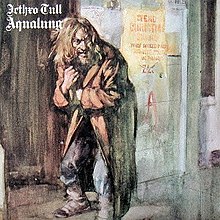
Back Aqualung (album) Czech Aqualung (Album) German Aqualung Greek Aqualung (álbum) Spanish Aqualung Finnish Aqualung (album) French Aqualung HE Aqualung Hungarian Aqualung (Jethro Tull) Italian アクアラング (ジェスロ・タルのアルバム) Japanese
| Aqualung | ||||
|---|---|---|---|---|
 | ||||
| Studio album by | ||||
| Released | 19 March 1971 | |||
| Recorded | April 1970 – February 1971[1] | |||
| Studio |
| |||
| Genre | ||||
| Length | 42:55 | |||
| Label | Chrysalis/Island (Europe) Reprise (America, Japan and Oceania) | |||
| Producer | Ian Anderson, Terry Ellis | |||
| Jethro Tull chronology | ||||
| ||||
| Singles from Aqualung | ||||
| ||||
Aqualung, released in March 1971 by Chrysalis Records, is the fourth studio album by the rock band Jethro Tull. Though it is generally regarded as a concept album, featuring a central theme of "the distinction between religion and God", the band have said there was no intention to make a concept album, and that only a few songs have a unifying theme.[4] Aqualung's success signalled a turning point in the career of the band, who went on to become a major radio and touring act.
Recorded at Island Records' new recording studio in Basing Street, London, it was their first album with keyboardist John Evan as a full-time member, their first with new bassist Jeffrey Hammond, and last album featuring Clive Bunker on drums, who left the band shortly after the release of the album. The album utilises more acoustic material than previous releases; and—inspired by photographs of homeless people on the Thames Embankment taken by singer Ian Anderson's wife Jennie Franks—contains a number of recurring themes, addressing religion along with Anderson's own personal experiences.
Aqualung is Jethro Tull's best-selling album, selling more than seven million units worldwide. It was generally well-received critically and has been included on several music magazine best-of lists. The album spawned two singles, "Hymn 43" and "Locomotive Breath".[5]
- ^ "IAN ANDERSON on JETHRO'S controversial 'Aqualung' LP". tullpress.com. Retrieved 26 November 2020.
- ^ "Jethro Tull singles". Dutchcharts.nl.
- ^ "Jethro Tull singles". Dutchcharts.nl.
- ^ Cite error: The named reference
Rolling Stone Reviewwas invoked but never defined (see the help page). - ^ "Jethro Tull - Locomotive Breath (song)". Norwegiancharts.com. Media Control Charts. Retrieved 30 March 2016.